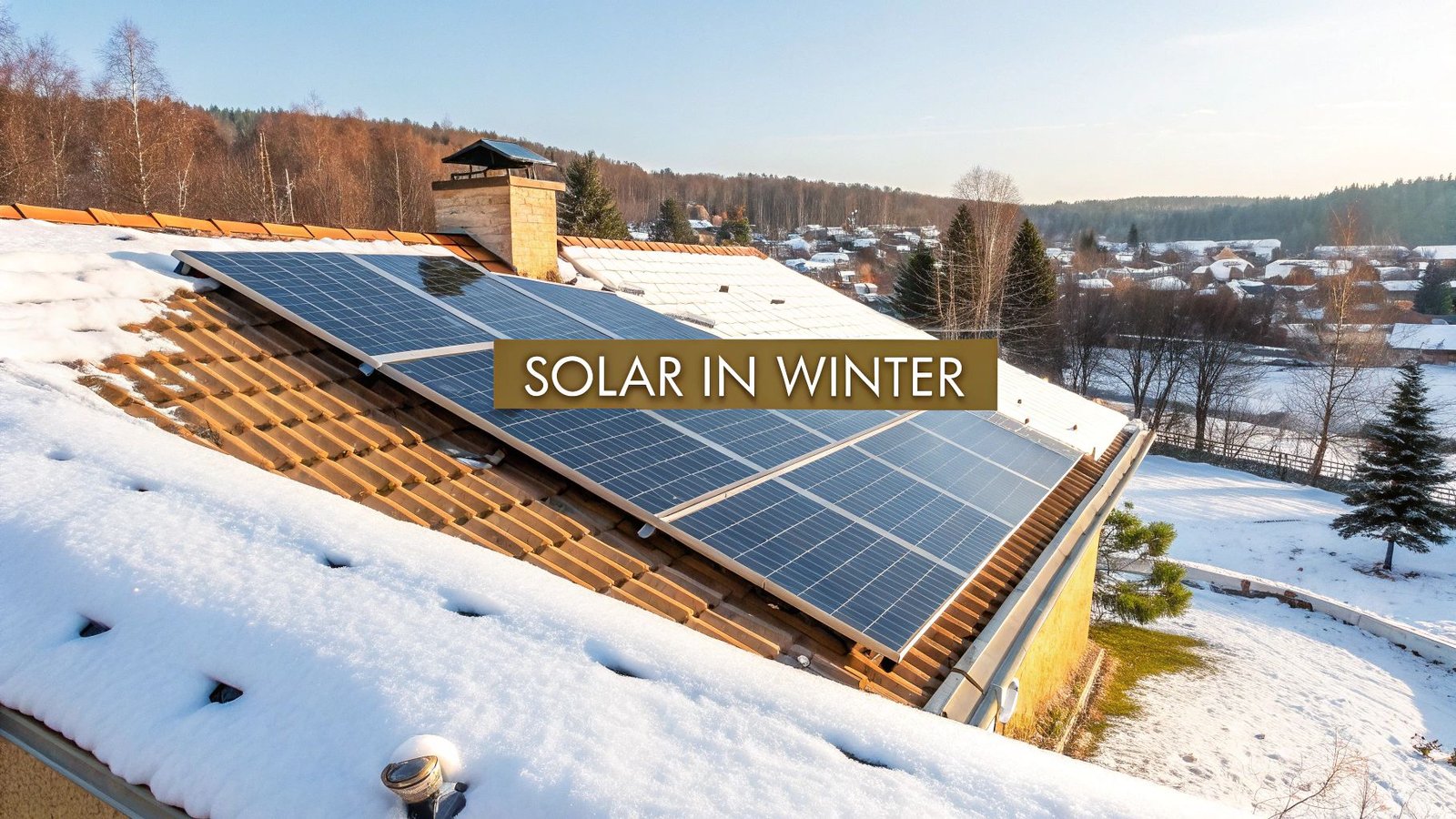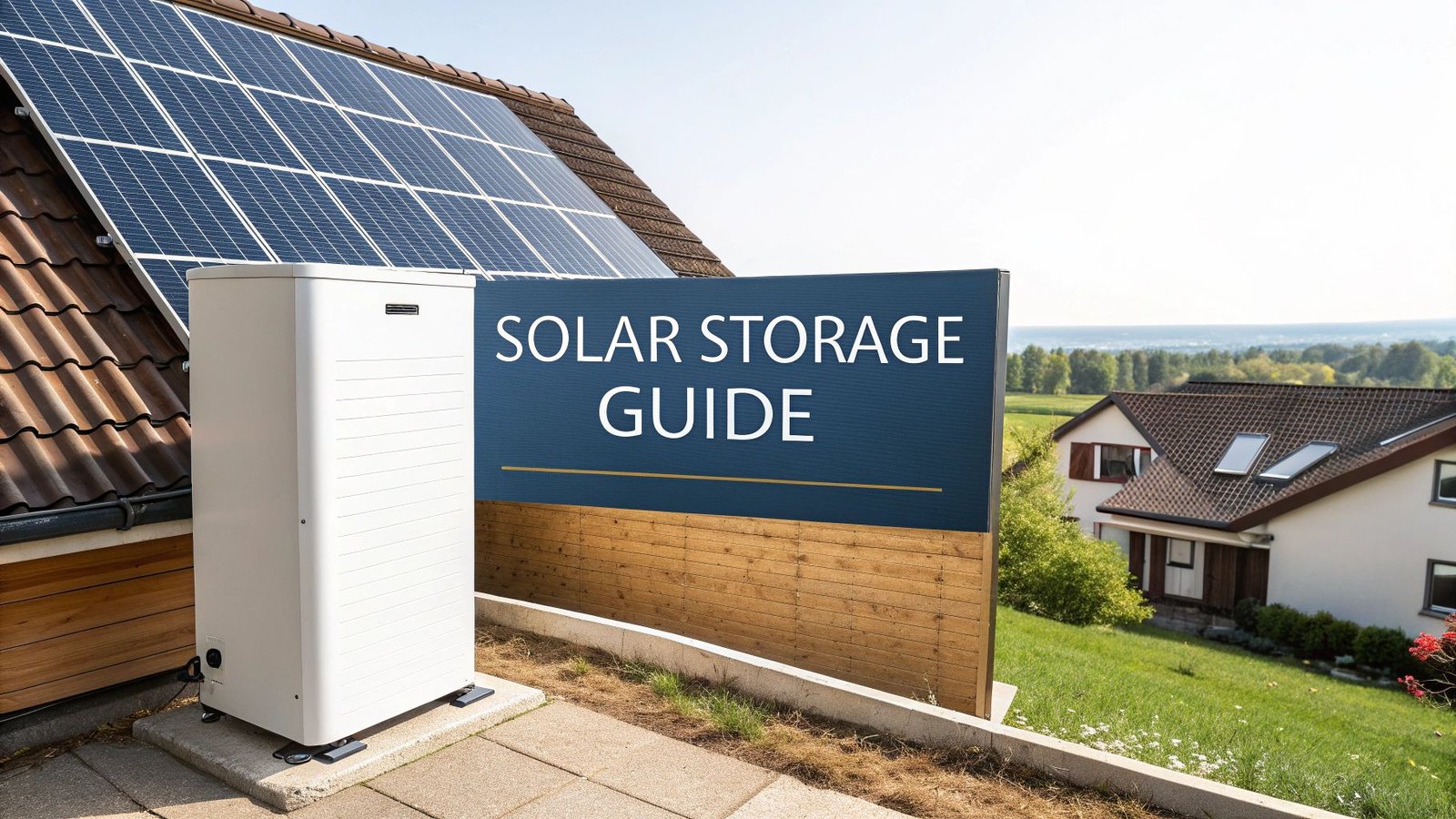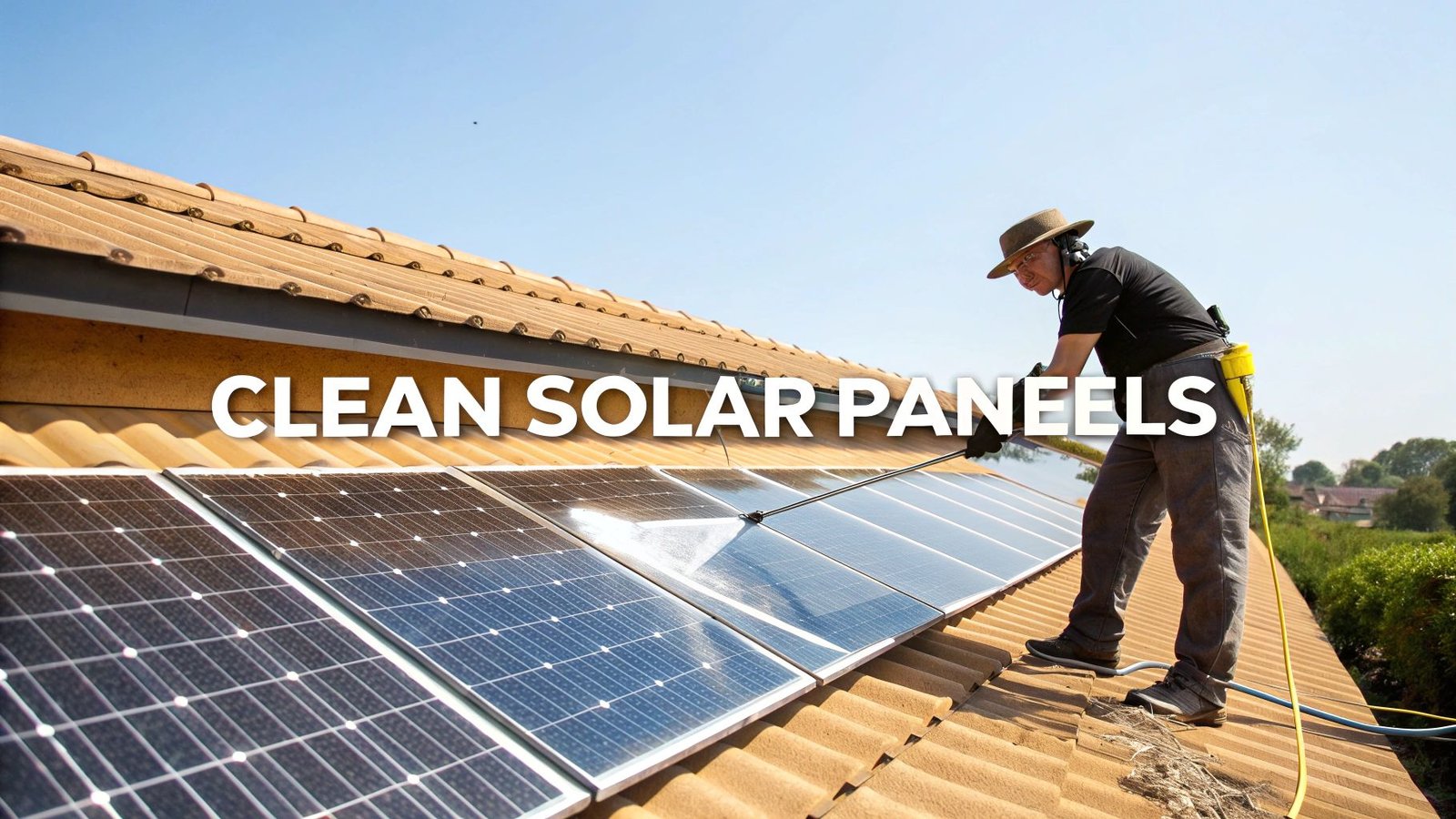Yes, solar panels absolutely work in winter. While it's true that shorter days mean less overall energy production, a surprising scientific fact flips the script on winter performance: cold weather actually makes your solar panels more efficient at converting sunlight into electricity.
The Surprising Truth About Winter Solar Performance
It's one of the first questions I get from homeowners considering solar: "But what happens in the winter?" It's a fair question. Frigid temperatures, fewer daylight hours, and the threat of snow seem like a perfect storm for a dormant solar array.
But that assumption misses a crucial part of the story. Your solar panels are definitely not hibernating from November to March. While your total energy generation will be lower than in the long, sunny days of July, your system is still busy producing clean, valuable energy. To really get it, you need to understand the two big factors at play: sunlight availability and panel efficiency.
Less Fuel But A Better Engine
Think of sunlight as the fuel for your solar panels and the panel itself as an engine. In winter, you obviously have fewer hours of available fuel, which naturally means less total output for the day. Simple enough.
But here’s the fascinating part: the engine—your solar panel—actually runs better in the cold. Just like most electronics, the photovoltaic (PV) cells in your panels perform more optimally in cooler conditions.
Most people assume heat is a solar panel's best friend, but it's actually the enemy of efficiency. On a scorching summer day, extreme heat can drag down a panel's output by as much as 10-25%. Solar panels are tested at a standard temperature of 25°C (77°F), and their performance drops as they get hotter.
Cold weather does the opposite. It lowers the electrical resistance inside the solar cells, letting electrons move more freely. This means they generate more power from every single ray of sun they capture. It creates an interesting trade-off that helps keep your system productive all year long. You can dig deeper into how temperature impacts solar efficiency and see the data behind these findings.
To put it all together, here’s a quick rundown of what winter weather means for your solar production.
Winter Solar Performance Factors At a Glance
| Winter Factor | Impact on Solar Production | Brief Explanation |
|---|---|---|
| Colder Temperatures | Positive | Cooler weather improves the efficiency of photovoltaic (PV) cells, allowing them to convert sunlight to electricity more effectively. |
| Shorter Daylight Hours | Negative | Fewer hours of sunlight mean less total time for the panels to generate power each day, reducing overall daily production. |
| Lower Sun Angle | Negative | The sun is lower in the sky, meaning its rays are less direct and intense, which slightly reduces the energy hitting the panels. |
| Snow Cover | Both | While heavy snow can block panels, a light dusting often melts off. Surrounding snow can also reflect more sunlight onto the panels (albedo effect). |
As you can see, winter isn't a simple "on" or "off" season for solar. It’s a dynamic period where different environmental factors push and pull on your system's total output.
Why Your Solar Panels Secretly Love The Cold
It sounds completely backward, doesn't it? But your solar panels have a surprising affinity for the cold. While we’re bundling up in sweaters and jackets, our solar arrays are often working at peak efficiency. The key is understanding one simple fact: sunlight and heat are not the same thing when it comes to generating power.
Most electronic devices, from your laptop to the components in a massive power grid, just run better when they're cool. Your solar panels are no different. In fact, extreme heat is the real enemy of solar efficiency, not the winter chill. A bright, sunny day with freezing temperatures can actually be a powerhouse for energy generation.
To get a handle on why, think of the electrons inside your solar panel's photovoltaic (PV) cells as cars on a highway, all racing to deliver energy.
Heat Creates a Traffic Jam
On a sweltering summer day, the intense heat agitates the electrons, creating a chaotic, congested highway. This "traffic" slows everything down. It causes electrical resistance and makes it much harder for the cars (the electrons) to move freely. The result is a less efficient system and lower power output for every ray of sunlight your panels capture.
Now, picture that same highway in the crisp cold of winter. It’s wide open. The low temperature calms the electrons, clearing the traffic and drastically reducing resistance. This allows them to flow smoothly and quickly, generating more power far more effectively. A five-year study by the Northern Alberta Institute of Technology even confirmed that energy loss from snow was minimal—around 3%—and that cold temperatures can genuinely improve panel output.
This phenomenon is so consistent that the solar industry has a specific metric to measure it: the temperature coefficient. It tells you exactly how much efficiency a panel loses for every degree the temperature rises above its ideal testing condition of 25°C (77°F).
Understanding The Temperature Coefficient
Every solar panel you can buy has a temperature coefficient rating. You'll typically see it listed as a number between -0.20%/°C and -0.50%/°C. This little number represents the percentage of output power the panel will lose for each degree Celsius its surface temperature increases above that 25°C baseline.
Here’s a real-world look at how that plays out:
!function(e,i,n,s){var t=”InfogramEmbeds”,d=e.getElementsByTagName(“script”)[0];if(window[t]&&window[t].initialized)window[t].process&&window[t].process();else if(!e.getElementById(n)){var o=e.createElement(“script”);o.async=1,o.id=n,o.src=”https://e.infogram.com/js/dist/embed-loader-min.js”,d.parentNode.insertBefore(o,d)}}(document,0,”infogram-async”);
-
Hot Summer Day: A panel with a -0.4%/°C coefficient is baking in the sun at 45°C (113°F). It's operating 20°C above its ideal temperature. That means you're looking at an 8% drop in efficiency (20°C x -0.4%).
-
Cold Winter Day: Now, that same panel is on your roof on a bright, freezing day at 5°C (41°F). It's now 20°C below its ideal temperature. That same math works in reverse, resulting in an 8% gain in efficiency.
The data doesn't lie—cold, sunny conditions provide a significant performance boost. So, when people ask if solar panels work in winter, the science is clear. Not only do they work, but the cold weather actually helps them operate at a higher level of efficiency, turning chilly days into surprisingly productive ones for your home's energy supply.
The Real Winter Challenge: Shorter Days and a Lower Sun
So, if cold weather actually helps solar panels work better, why does your energy production chart always take a nosedive in winter? The answer has nothing to do with a flaw in your system. It's all about the "fuel."
The true culprit behind lower winter solar generation isn't the temperature; it’s the sun's position in the sky and the simple fact that there’s less of it to go around.

This reality is governed by two main factors: the length of the day and the angle of the sun. Together, they team up to reduce the total amount of solar energy that can even reach your panels, which directly caps how much electricity you can generate.
Fewer Peak Sun Hours
To really get a grip on winter production, you need to understand the concept of "peak sun hours." This isn’t just a count of daylight hours from sunrise to sunset. It’s a measure of how many hours your panels are bathed in sunlight intense enough to produce their maximum rated power.
Think of it as the "high-octane" sunlight your system craves to perform at its best.
In the summer, the days are long, and the sun rides high in the sky, delivering hours and hours of this powerful light. But in winter, the script flips completely. The days are noticeably shorter, which slashes the available time your panels have to do their job.
The difference can be dramatic. Let's look at how peak sun hours change from summer to winter in a few U.S. cities.
Average Peak Sun Hours Summer vs Winter
!function(e,i,n,s){var t=”InfogramEmbeds”,d=e.getElementsByTagName(“script”)[0];if(window[t]&&window[t].initialized)window[t].process&&window[t].process();else if(!e.getElementById(n)){var o=e.createElement(“script”);o.async=1,o.id=n,o.src=”https://e.infogram.com/js/dist/embed-loader-min.js”,d.parentNode.insertBefore(o,d)}}(document,0,”infogram-async”);
| City | Summer Peak Sun Hours (Daily Avg) | Winter Peak Sun Hours (Daily Avg) | Percentage Decrease |
| :— | :— | :— | :— |
| **Phoenix, AZ** | **7.5** | **5.0** | **33%** |
| **Miami, FL** | **5.5** | **4.5** | **18%** |
| **Seattle, WA** | **5.0** | **1.5** | **70%** |
| **Boston, MA** | **5.0** | **2.5** | **50%** |
As you can see, cities in northern latitudes like Seattle and Boston experience a much steeper drop-off in available sunlight compared to sunnier climates. Even in Phoenix, there’s a 33% reduction. This is the single biggest reason for lower winter output.
The Sun's Lower Angle
Making matters worse is the sun's low trajectory across the winter sky. During the summer, the sun passes nearly straight overhead, hitting your panels at an almost perfect, direct angle. This concentrates its energy into a tight, powerful beam—like a laser-focused spotlight.
In winter, the sun barely climbs above the horizon. Its rays arrive at a much shallower angle, forcing the same amount of solar energy to spread out over a much larger area. It’s the difference between shining a flashlight straight down versus holding it at a slant; the angled beam is always dimmer and more diffuse.
This lower intensity means less energy is hitting each individual solar cell, further reducing your system's hourly production. Getting this angle right is a huge part of solar installation, which is why a common question is what direction should solar panels face for the best year-round results.
While lower output is normal, extreme winter weather can pose much bigger threats to our entire energy grid. The massive grid failure during the 2021 Texas freeze is a stark reminder of this. Understanding the Winter Storm Uri Energy Sector Impact shows just how vulnerable our infrastructure can be to severe cold, highlighting the need for resilient energy sources.
At the end of the day, reduced winter solar production is just simple math. Your panels are just as efficient—if not more so—but there’s simply less fuel available for them to convert into electricity.
How to Handle Snow on Your Solar Panels

Ah, snow. It’s the most obvious sign of winter and the one thing that makes new solar owners a bit nervous. After all, if the panels are covered, they can't make power, right? While a heavy blanket of snow will temporarily halt production, it's rarely the catastrophe people imagine.
Believe it or not, the best course of action is often to just do nothing.
Solar panels are pretty good at taking care of themselves. Their dark, slick surfaces are angled to catch the sun, and this setup works wonders for shedding snow. As soon as the sun peeks out, that dark glass warms up just enough to melt the very bottom layer of snow, letting the rest slide right off. For a light, fluffy snowfall, you’ll often see your panels clear themselves within a day.
Of course, heavy, wet snow or a layer of ice can be a different story. That stuff can stick around for a while, and yes, your energy production will flatline until it’s gone. But even then, the lost production over a few snowy days is usually just a tiny blip in your total annual output.
The Surprising Albedo Effect
Before you grab a rake and head outside, let me tell you about a fascinating winter quirk called the albedo effect. It’s a fancy term for how well a surface reflects sunlight. Fresh, white snow has a really high albedo—it’s basically a giant, natural mirror laid out across your yard.
So, what does this mean for you? Once your panels are clear, all that surrounding snow reflects extra sunlight up onto them. This can give your system a surprising performance boost, sometimes even generating more power than on a clear, snow-free day.
A five-year study by the Northern Alberta Institute of Technology looked at this exact issue. They found that energy loss from snow was incredibly low, averaging just 3% over an entire winter. This really drives home the point that letting nature do its thing is a perfectly sound strategy for most homeowners.
When and How to Safely Remove Snow
Still, I get it. Some people just can't stand to see their panels covered. If you decide you absolutely must clear them, safety has to be your number one concern. Climbing on a snowy, icy roof is a terrible idea and something we strongly advise against. Only try to clear panels if you can do it safely from the ground.
If you’re going to do it, do it right:
- Get the Right Tool: The best tool for the job is a long-handled snow rake with a soft, squeegee-like head. This lets you gently pull the snow down without ever touching the glass.
- No Abrasives Allowed: Never, ever use a metal rake, a hard plastic shovel, or a stiff brush. You’ll scratch the anti-reflective coating on the glass, which will permanently hurt your panels’ performance.
- Skip the Hot Water: It might seem like a clever shortcut, but pouring hot water on frozen glass is a recipe for disaster. That sudden temperature shock can cause micro-cracks or even shatter the panel entirely.
For anyone living in a place that gets regular snowfall, knowing the right way to handle it is key. We go into a lot more detail in our dedicated article on solar panels and snow removal. In the end, it’s a personal call—weighing the minimal energy you might gain against the effort and, most importantly, the risk.
Getting the Most Out of Your Panels This Winter
It’s one thing to know your panels will keep working when it gets cold, but it’s another to help them perform at their absolute best. You can take a few simple, practical steps to wring every last watt out of the weaker winter sun.
Think of it as turning a season of lower production into one of peak efficiency. These strategies range from basic upkeep to smarter system management, and they all help you work with the season, not just put up with it.
Fine-Tune Your System for the Low Sun
If your mounting system allows for it, one of the best things you can do is adjust your panel's tilt angle. The sun hangs much lower in the winter sky, and a steeper angle helps your panels face it more directly. It’s like tilting your face up to feel the warmth on a chilly afternoon—that small shift makes a huge difference.
- What’s the best angle? A good rule of thumb is to take your latitude and add 15 degrees. So, if you live in Boston (latitude 42°), your ideal winter tilt would be around 57 degrees.
- Can your system adjust? Not all can. This is a common feature for ground-mounted arrays and some specialized roof mounts, but most standard rooftop systems are fixed in place.
A clean panel is an efficient panel. Autumn leaves, dust, and grime build up over the warmer months, creating a film that blocks precious sunlight. A good cleaning before the first snow ensures your panels start the season with a clean slate.
Keep Your Panels Clean and Clear
While a good snowfall will often slide right off, giving your panels a pre-winter cleaning can really pay off. That thin layer of dust and grime can cut into your efficiency by a few percentage points, and over the course of a whole season, that lost energy adds up.
Washing them down prepares them to absorb every bit of light from the very first day of winter. But before you grab a ladder, make sure you're using the right tools and techniques to avoid scratching the glass. We walk you through the whole process safely in our complete guide on how to clean solar panels.
Use Your Monitoring and Storage to Your Advantage
Your energy monitoring system is your most valuable tool in the winter. Make a habit of checking your daily production charts. This data is a goldmine—it shows you exactly how different weather patterns affect your output and can even alert you if a single panel is underperforming, maybe because of a stubborn patch of snow or some debris.
If you have a battery, you have an even bigger advantage. A solar battery lets you store the energy you generate during those bright but short winter afternoons. You can then tap into that stored power at night or on a dreary, overcast day, giving you more energy independence when the grid is working its hardest.
Frequently Asked Questions About Winter Solar Power
Even with all the science laid out, it's completely normal to have a few questions still rattling around. We get it. When you’re talking about your home’s energy, you want to be 100% confident. Here, we'll tackle the most common questions homeowners ask us about how their solar panels hold up when the temperature drops.
Our aim is simple: give you clear, no-nonsense answers to help you feel great about your solar investment, no matter what the weather report says.
Will Heavy Snow or Hail Actually Damage My Solar Panels?
This is a big one, especially for anyone living where winter means business. The short answer? It's incredibly unlikely. Solar panels are built like tanks.
Manufacturers don't just hope for the best; they put their panels through some serious abuse to ensure they can handle extreme weather. Think simulations of crushing snow loads and even cannons firing hail-sized ice balls at them at highway speeds. That tempered glass on top is tougher than it looks.
Of course, a once-in-a-century superstorm could damage anything on your roof, but your standard winter blizzard or hailstorm is exactly what modern panels are designed to withstand. Plus, their slanted position is a natural defense, encouraging snow to slide right off instead of piling up and adding too much weight.
How Much Less Energy Should I Expect My Panels to Make in Winter?
This really depends on where you call home. Your local climate and how far north you live are the two biggest factors that will dictate your winter production.
To give you a rough idea:
- Northern Climates: If you're in a place with short days and lots of gray skies, like the Northeast or Pacific Northwest, you might see production drop by 50-60% compared to the long days of summer.
- Southern Climates: Down in sunnier regions like the Southwest, the dip might only be around 20-30%.
It all comes down to your area's "peak sun hours" and how much snow you typically see. But don't sweat this part—any good solar installer will have already baked these seasonal shifts into your initial production estimate, so you'll have a realistic picture of your system's output all year long.
Is It Still Worth Getting Solar in a Snowy Climate?
Absolutely, yes. A solar investment is always calculated based on your annual production, not just what happens during the sunniest months. Installers in snowy regions are pros at designing systems and forecasting savings that account for lower winter output from the get-go.
The boost in efficiency on those crisp, bright, sunny winter days actually helps make up for the days when the panels are covered in snow. Even better, programs like net metering let you bank excess energy credits you produce during the summer. You can then use those credits to wipe out your utility bills in the winter, making solar a financially sound choice no matter how high the snowdrifts get.
Do I Need a Battery for My Panels in Winter?
A battery isn't a must-have for your panels to work in the winter. With a standard grid-tied system, your panels will power your home or feed the grid anytime the sun is out. When they aren't producing—like at night or during a blizzard—you just pull power from the grid like you always have.
That said, adding a battery brings some powerful advantages to the table, especially during the winter. A battery lets you store the solar energy you generate on a clear day and save it for when you need it most. That could be overnight, or more importantly, during a winter storm that knocks out the power lines. It's the key to real energy independence and provides that critical backup power to keep the lights on when the rest of the neighborhood goes dark.
Ready to see how solar can power your home through every season? The team at Radiant Energy is here to design a system that maximizes your energy production year-round, giving you peace of mind and lower electricity bills. Explore your options and get a free quote today.




